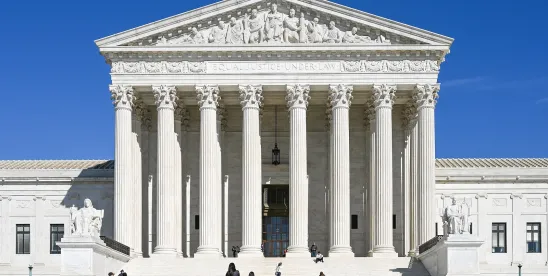On June 13, 2024, the U.S. Supreme Court held in Vidal v. Elster that protecting a living individual’s good name trumps the First Amendment in the context of trademark registrations. Collectively, the three opinions unanimously held that the U.S. Patent and Trademark Office (USPTO)’s legislative-based refusal to register the mark TRUMP TOO SMALL did not violate the First Amendment. Rather than a third domino in the chain of decisions overturning Lanham Act Section 2 bars to registration (See Matal v. Tam, 582 U.S. 218; Iancu v. Brunetti, 588 U.S. 388), Vidal v. Elster halts the pruning of Lanham Act Section 2 with the majority’s foot planted firmly in trademark law history and tradition.
What’s In a Name? A Bar to Federal Trademark Registration
15 U.S.C. § 1052(c) states, in relevant part, that a valid trademark will not be refused registration unless it comprises a name identifying a particular living individual without that individual’s consent. Although there are at least two Lanham Act provisions devoted to names, the Supreme Court adopts the term “names clause” to refer to Lanham Act § 2(c) throughout the various opinions, likely bringing this term into common trademark parlance.
In 2018, Steve Elster applied to register the mark TRUMP TOO SMALL for shirts. The USPTO rejected the application under the names clause because the mark refers particularly to Donald Trump without Donald Trump’s consent. Elster appealed the refusal to the Trademark Trial and Appeal Board, arguing that the refusal to register violated his First Amendment right to criticize a government official. The Board upheld the refusal, but the Federal Circuit reversed and held that the First Amendment entitled Elster to register the mark. The Supreme Court granted certiorari in June 2023.
Through a majority opinion authored by Justice Thomas and concurrences authored by Justices Barrett and Sotomayor, the Court unanimously held that the names clause does not violate the First Amendment. But in their contrasting discussions of trademark law, the Justices disagreed on why there was no conflict.
What the Justices Agreed on
The three opinions agreed that each refusal basis under Lanham Act Section 2, which governs the federal registration of trademarks and service marks, is a content-based regulation of speech. This is because the registrability of the mark cannot be determined without knowing what the mark is (i.e., the content of the application) and applying various rules to the mark-goods or mark-services combination. And although some content-based regulations of speech are presumed unconstitutional unless proven otherwise, all Justices agreed that Lanham Act Section 2 did not fall into this category.
The three opinions also agreed that unlike the previously struck prohibitions against the registration of disparaging marks and scandalous marks, which were viewpoint-based regulations of speech, the prohibition against registering a particular individual’s name without their consent – essentially a yes or no question – was viewpoint-neutral. In reaching this consensus, the Justices universally rejected Elster’s argument that the consent requirement would disproportionately silence mocking particular individuals (in favor of flattering them) because individuals might consent to the registration of a positive viewpoint about them but reject registration of a negative viewpoint about them. The Justices reasoned that people commonly withhold their consent to register marks incorporating positive viewpoints about them because they do not want to be associated with the third party’s goods (and their potential defects) and do not want the commercial value of their name exploited by another.
Finally, all Justices agreed that the question of whether a content-based, viewpoint-neutral speech restriction such as the names clause was constitutional was a question of first impression uninfluenced by the prior Tam and Brunetti decisions.
What the Justices Disagreed on
The majority’s “narrow” opinion opted to answer only the question of whether the names clause traversed into the realm of an unconstitutional restriction on speech while expressly sidestepping the opportunity to “set forth a comprehensive framework for judging whether all content-based but viewpoint-neutral trademark restrictions are constitutional.” And the majority’s framework-free reasoning was a purported history lesson, beginning with early common law and ending with Lanham Act Section 2(c), to show that the legal principle that a person has a property right in his name is sufficiently historical and traditional “to conclude that the names clause . . . is compatible with the First Amendment.” In other words, if it ain’t broke and it’s the names clause, don’t fix it.
Both Justice Barrett and Justice Sotomayor would have instead adopted a “reasonableness” test weighing the purpose of the restriction against the impact of the restriction on speech rather than the “tradition itself test” (Justice Barrett) or “history-and-tradition test” (Justice Sotomayor). And, applying the hypothetical reasonableness test, both Justices thought the names clause reasonably serves the trademark system’s purpose – facilitating source identification and preventing consumer confusion – and therefore does not violate the First Amendment.
Why Trademark Cases Are Likely to Remain on SCOTUS’s Wish List
Although the body of the decision resembled Tam and Brunetti, the denouement of the decision resembled parts of the 2023 Jack Daniel’s v. VIP Products opinions. In VIP Products, the majority opinion expressly noted that “Today’s opinion is narrow,” while Justice Gorsuch’s concurrence seemingly invited a case to pressure test the Rogers test – “[I]t is not obvious that Rogers is correct in all its particulars—certainly, the Solicitor General raises serious questions about the decision . . . All this remains for resolution another day . . . and lower courts should be attuned to that fact.” Here, the majority opinion paraphrased its prior admonition, stating “Our decision today is narrow” and even more forcefully invited future trademark law discourse – “In a future case, we can address the ‘distinct question’ whether ‘a viewpoint-neutral, content-based trademark restriction’ is constitutional without ‘such a historical pedigree.’” Accordingly, while hindsight suggests that the Court accepted this case to return the Lanham Section 2(c) status quo upended by the Federal Circuit, trademark law fans can anticipate further discussion – and perhaps respectful disagreement – amongst the Justices on many hotly debated trademark topics.




 />i
/>i
